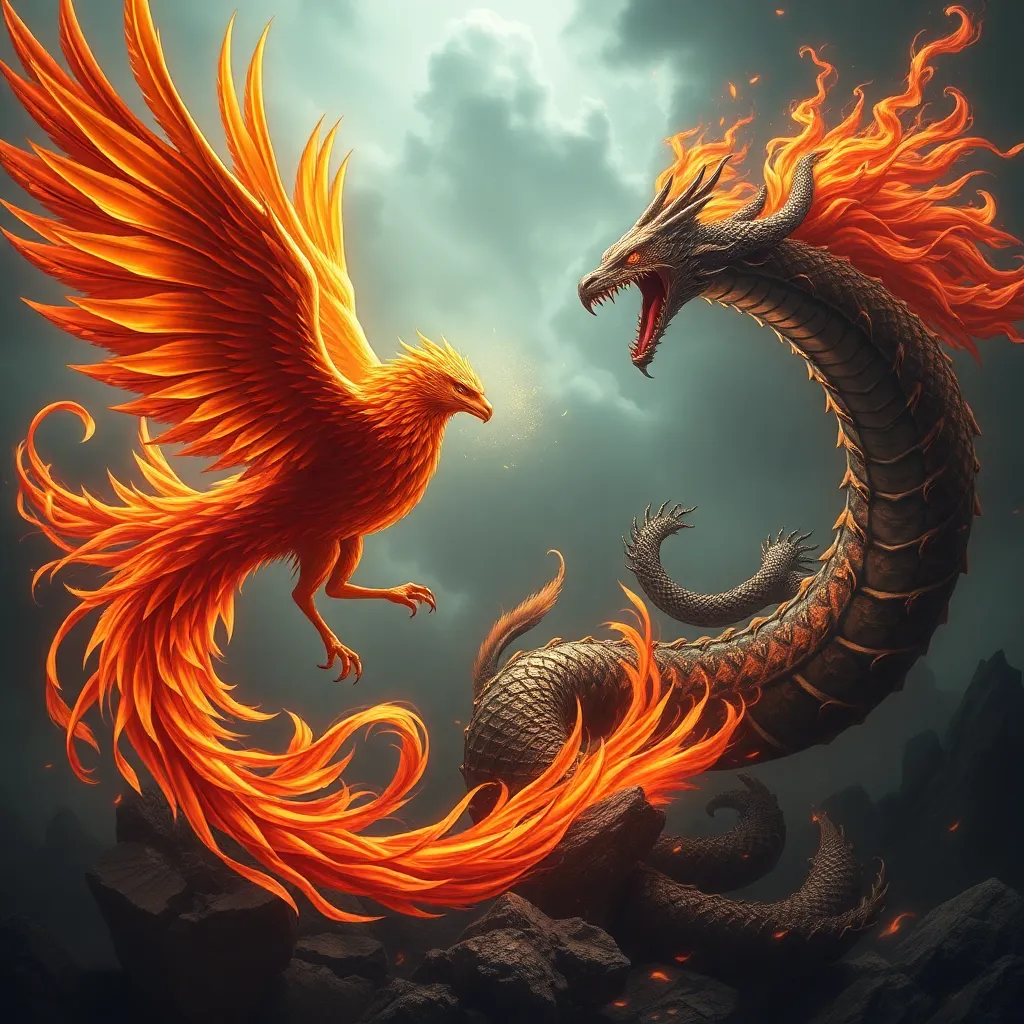The Phoenix and the Serpent: A Battle of Transformation in Classical Mythology
I. Introduction
Transformation is a central theme in mythology, representing the continuous cycle of change inherent in life. Myths often encapsulate the struggle between opposing forces, and the Phoenix and the Serpent serve as potent symbols in this narrative. The Phoenix, with its association with rebirth, and the Serpent, often linked to duality and destruction, highlight the complexities of transformation. This article explores the battle between these two mythical figures and delves into the implications of their conflict for understanding human experience.
II. The Mythical Origins of the Phoenix
The legend of the Phoenix is found in various cultures, each adding layers of meaning to this extraordinary bird. The most well-known accounts originate from ancient Egyptian and Greek mythology. According to legend, the Phoenix is a magnificent bird that bursts into flames upon death, only to rise anew from its ashes. This cycle of death and resurrection symbolizes the eternal nature of life.
- Egyptian Mythology: The Phoenix, known as the Bennu, is associated with the sun and creation, representing renewal and the cyclical patterns of life.
- Greek Mythology: The Phoenix is described as a beautiful bird that lives for several centuries before immolating itself, also emphasizing themes of rebirth.
- Chinese Mythology: The Fenghuang, or Chinese Phoenix, is a symbol of virtue and grace, embodying the harmony of yin and yang.
The symbolism of rebirth and renewal is paramount to the Phoenix’s legend. It embodies the cycle of death, where destruction gives way to new life. This transformative process resonates with the human experience, reflecting our own struggles and the potential for renewal in the face of adversity.
III. The Serpent in Mythology
In contrast to the Phoenix, serpents take on varied representations across different cultures. They are often seen as ambivalent creatures, embodying both creation and destruction. From the biblical serpent in the Garden of Eden to the serpent gods in Hindu mythology, these creatures illustrate the duality of existence.
- Temptation and Knowledge: In many myths, serpents symbolize temptation, as seen in the Judeo-Christian tradition, where the serpent leads to the fall of man.
- Transformation: Serpents are also associated with transformation, shedding their skin as a metaphor for renewal and change.
- Creation and Destruction: In some cultures, serpents are viewed as creators, such as the Mesoamerican feathered serpent deity Quetzalcoatl, who is linked to both existence and chaos.
The serpent’s role in mythology is multifaceted, representing the complexities of life, including the themes of temptation, transformation, and mortality. It serves as a reminder of the delicate balance between creation and destruction that characterizes the human experience.
IV. The Battle: A Metaphorical Interpretation
The battle between the Phoenix and the Serpent can be interpreted as a metaphorical conflict between life and death. The Phoenix embodies the essence of life, symbolizing hope, renewal, and the inevitability of change. In contrast, the Serpent represents death, temptation, and the darker aspects of transformation.
This conflict is rich in meaning, reflecting the dichotomies present in human existence:
- Life vs. Death: The Phoenix’s resurrection challenges the finality of death represented by the Serpent.
- Hope vs. Despair: The Phoenix’s flames offer hope, while the Serpent’s presence may evoke feelings of fear and despair.
- Change vs. Stagnation: The battle signifies the struggle to embrace change in a world often resistant to transformation.
The implications of their fight extend beyond myth, inviting reflection on the human condition. It encourages us to confront our fears, embrace transformation, and recognize the cyclical nature of existence.
V. Transformation as a Central Theme
Both the Phoenix and the Serpent embody the process of change, highlighting that transformation is an integral part of life. Their narratives illustrate the interplay of destruction and creation, showcasing how one cannot exist without the other.
Furthermore, the psychological and spiritual dimensions of transformation reveal deeper truths about human existence:
- Personal Growth: Just as the Phoenix rises from the ashes, individuals often experience growth through adversity.
- Spiritual Awakening: The shedding of the serpent’s skin symbolizes the shedding of old beliefs and the emergence of new understandings.
- Embracing Change: Both figures teach us the importance of embracing change, as it is through transformation that we discover our true selves.
VI. Cultural Representations and Interpretations
The Phoenix and the Serpent have been depicted in various forms of art and literature throughout history. Their imagery continues to inspire modern storytelling and symbolism:
- Art: Paintings, sculptures, and tattoos often utilize the Phoenix and Serpent to convey themes of transformation and duality.
- Literature: Myths, novels, and poetry frequently draw on these symbols to explore the complexities of human experience.
- Modern Media: Films and television shows often incorporate the Phoenix and Serpent motifs, reflecting contemporary struggles with change and identity.
A comparative analysis of their portrayals across cultures reveals both unique interpretations and universal themes, underscoring the timeless nature of their symbolism.
VII. Lessons from the Phoenix and the Serpent
The narratives of the Phoenix and the Serpent impart valuable lessons about life and transformation:
- Embracing Change: The importance of accepting and embracing change as a necessary part of life.
- Insights into the Human Condition: Mythological narratives offer profound insights into our struggles, fears, and aspirations.
- Relevance in Contemporary Life: The themes of transformation remain relevant, encouraging individuals to reflect on their own journeys and transformations.
VIII. Conclusion
The battle between the Phoenix and the Serpent is a powerful narrative that underscores the significance of transformation in classical mythology. Both figures symbolize essential aspects of the human experience, reflecting our struggles with life, death, and change. As we navigate our own transformative journeys, we can draw inspiration from these myths, recognizing that the cycles of destruction and creation are integral to our growth and understanding of ourselves.
As you reflect on your own experiences, consider the lessons imparted by the Phoenix and the Serpent, and embrace the transformational journeys that shape who you are.




